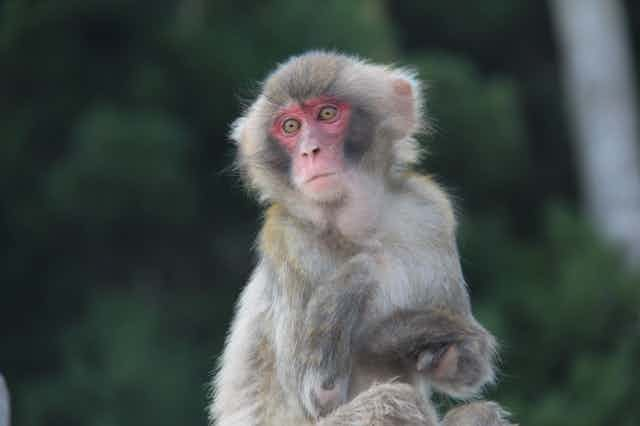Nina is a Japanese macaque, one of the red-faced monkeys famous for sitting in hot springs in Japan. Nina lives wild in the forest, but most days, along with her group, she visits the Awajishima Monkey Center to eat the food people provide for the monkeys.
Nina was born without hands, an unusually common occurrence in this group of macaques. While no one knows for sure why these malformations of the limbs and digits occur, many researchers have suggested a potential link to pesticides or other environmental contaminants.
Nina survived because of a combination of factors: her ability to modify her behaviours to compensate for her physical impairments; the extra care provided by her mother when she was little; and living in a group of monkeys who treat her much the same way they do non-disabled group members.

Over the years, we have spent many hours observing Nina and other disabled and non-disabled monkeys, as they live their lives — moving through the forest, socializing with others in their group and finding novel ways of adjusting their behaviours to compensate for physical impairments.
Disability is a normal part of human experience, with at least 16 per cent of people experiencing some form of disability. However, while conducting research at Awajishima, we have noticed that many people expect that disabled animals would be unlikely to survive. However, Nina and other disabled macaques in her group can survive and reproduce, and are far from being alone among primates of the world.
Primates and disability
In a recently published review of the literature on non-human primates and disability in the American Journal of Primatology, we found that physical impairment is more common among wild and free-ranging primates than most people might think.
We found 114 published papers on primates with disability, not including all the casual observations and field notes that were not published in the scientific literature. These papers included 37 species of non-human primates — monkeys, apes and lemurs — from 70 different study sites (38 of those with wild and free-ranging primates).

About 45 per cent of these disabilities, like Nina’s, were present from birth, while approximately 24 per cent came from injury, with similar frequency caused by a condition or illness.
Behavioural flexibility or plasticity (the ability to modify activities and actions in response to specific circumstances), the innovation of novel behaviours and extra maternal care stood out in the published research papers.
Seventy papers reported on ways that primates used behavioural flexibility and innovations to compensate for physical impairments, or provided examples of mothers who were able to support the needs of their physically impaired offspring. There were also some instances of other relatives and group members also providing support.
Overall, there was little evidence of social selection against disabled primates. There were also many examples of undifferentiated treatment for disabled individuals, and a few examples of disability-associated care behaviours.
Human causes of primate disability
Having studied disabled monkeys, we were not surprised to learn about the behavioural plasticity we found in this review. What was more surprising to us was just how many of these disabilities were linked to anthropogenic activities.
There are many ways that human activities can lead directly and indirectly to long-term disability in our closest animal relatives. Sixty per cent of the published examples of primate disability we surveyed were linked to human causes.
These included: injuries from hunting snares among chimpanzees and gorillas; injuries sustained on roads or from electrical wires in South African baboons and South American howler monkeys; and the effects of diseases transmitted between human and non-human primates.

Human pressure, increasing threats
At a time when the majority of non-human primates are experiencing declining populations and are threatened with extinction, this link between human activities and physical impairments in primates is a poignant reminder of how humans are impacting other life on Earth.
Wherever non-human primates are found in the world — throughout the tropics and as far north as Japan — they face compounding threats from human pressures. As humans increasingly convert forests and wild lands to agricultural and urban spaces, habitat loss is pushing many primate species towards extinction.
These pressures are exacerbated by resource extraction (often to meet market demand from the Global North), hunting, the exotic pet trade and disease. The threat of major impacts from climate change is also looming on the horizon. Even the most behaviourally flexible, smart, care-giving and innovative of individuals and species may not be able to navigate the scope and variety of these changes and pressures.
Physically impaired and disabled primates often find ways to behaviourally compensate for their impairments, survive and reproduce.
Nina and her friends show us an important side of non-human primate behaviour, giving us a model to examine the capacity for behavioural flexibility in nonhuman primates. Our research also underscores the critical role that humans have in shaping the futures of our closest animal relatives.


